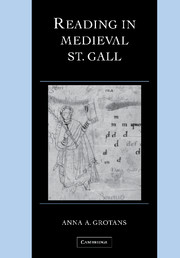
-
Select format
-
- Publisher:
- Cambridge University Press
- Publication date:
- May 2010
- May 2006
- ISBN:
- 9780511483301
- 9780521803441
- 9781107405295
- Dimensions:
- (247 x 174 mm)
- Weight & Pages:
- 0.8kg, 380 Pages
- Dimensions:
- (244 x 170 mm)
- Weight & Pages:
- 0.61kg, 380 Pages
You may already have access via personal or institutional login
Book description
Learning to read in medieval Germany meant learning to read and understand Latin as well as the pupils' own language. The teaching methods used in the medieval Abbey of St Gall survive in the translations and commentaries of the monk, scholar and teacher Notker Labeo (c.950–1022). Notker's pedagogic method, although deeply rooted in classical and monastic traditions, demonstrates revolutionary innovations that include providing translations in the pupils' native German, supplying structural commentary in the form of simplified word order and punctuation, and furnishing special markers that helped readers to perform texts out loud. Anna Grotans examines this unique interplay between orality and literacy in Latin and Old High German, and illustrates her study with many examples from Notker's manuscripts. This study has much to contribute to our knowledge of medieval reading, and of the relationship between Latin and the vernacular in a variety of formal and informal contexts.
Reviews
"Reading in Medieval St. Gall is now the best study in English of one of the most important figures in medieval German literature, Notker Labeo...Grotans has been a pioneer in squarely placing Notker in his medieval pedagogical context, a context that she knows like scarcely any other."
-Robert G. Sullivan, University of Massachusetts, Amherst, Journal of Medieval Studies
Contents
Metrics
Altmetric attention score
Full text views
Full text views help Loading metrics...
Loading metrics...
* Views captured on Cambridge Core between #date#. This data will be updated every 24 hours.
Usage data cannot currently be displayed.
Accessibility standard: Unknown
Why this information is here
This section outlines the accessibility features of this content - including support for screen readers, full keyboard navigation and high-contrast display options. This may not be relevant for you.
Accessibility Information
Accessibility compliance for the PDF of this book is currently unknown and may be updated in the future.


